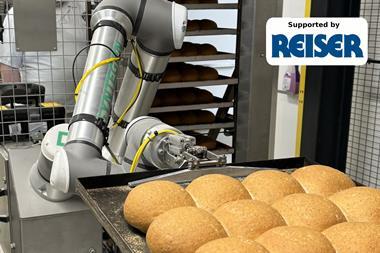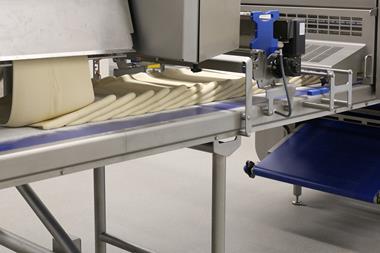While technological advances are making metal detectors more efficient, calibration and validation checks remain essential elements of the food safety mix
Andy and Lance in TV sitcom The Detectorists have plenty of ups and downs in their search for Britain’s hidden treasure – but their metal detecting is a walk in the park compared to the challenge of finding contaminants in baked goods.
All the moisture and salt in a loaf of bread can cause headaches for metal detection systems. When a loaf leaves a cooling tunnel on its way to packing, the mixture inside will still be wet, explains Mike Bradley, head of sales at Mettler Toledo Safeline (MTS).
“That moisture has historically been the biggest challenge for a metal detector as it creates what is called a product effect. This can lead to false rejects as the moisture is often mistaken for a foreign body.”
Bradley says his company has taken significant steps to deal with this, as its Profile Advantage system uses algorithms that allow it to treat products as if they were dry. This improves detection sensitivity and eliminates false rejects, according to the manufacturer.
MTS adds that Profile Advantage can deal with a variety of products, and allows bakers to put multiple product types through the metal detector on a common setting – effectively meaning it can be ignored during changeovers as it will automatically recognise the product.
“This helps manufacturers achieve maximum productivity through reduced downtime,” adds Bradley.
Downtime can also be reduced, and reliable performance maintained, through periodic calibration and validation checks.
Discarded product
As these checks can halt production several times a shift, users may be tempted to reduce the frequency, suggests Sarah Ketchin, managing director at Fortress Technology. “But users need to bear in mind that the longer the interval, the more product may have to be discarded or recalled if a problem with the inspection system is discovered,” she adds.
Users will generally carry out hourly checks using certified test pieces to ensure the machinery is detecting at the required levels, says Tony Bryant, UK sales director at Loma Systems, adding this is typically a retailer requirement rather than a metal detector supplier recommendation.
When it comes to calibration, Loma provides an annual service carried out by trained engineers. “This gives a kind of MOT, as well as making any minor adjustments,” says Bryant.
Bradley at MTS says set-up, verification and validation of settings are key. “We provide specific guidelines as to how to set up the metal detector in a way that ensures the specification we set is detectable 100% of the time, and that the settings customers run on their lines do not lead to false rejects.
Verification protocols
“The metal detectors also have built-in verification protocols that align with all the relevant food safety and retailer standards. These settings can be adjusted for specific customers to ensure compliance with the varying specifications across retail brands.”
Profile Advantage’s use of Predictive Analytics enables users to reduce the number of performance monitoring tests by analysing the sensitivity of the detector and producing an alarm should the system identify a change that could result in a reduction in system sensitivity.
“A reduction in frequency of testing from, for example, six times a day to twice could result in financial payback through greater productivity and equipment effectiveness improvements,” says Bradley.
Case study: Borgesius Bakery takes two-in-one approach
Dutch firm Borgesius recently took delivery of a twin-lane multi-aperture Stealth metal detector, built in the UK by Fortress Technology.
Dutch manufacturer Jansen Control Systems supplied the customised installation, integrating the twin-
aperture single metal detector with a new section of easy-to-clean conveyor and two reject systems, one for each lane. Incorporated with the bakery’s existing cooling tower, the entire footprint of the new inspection system is less than 1.7m at its widest point and less than 5m in length.
“Rather than having one metal detector head spanning both lanes, the bakery wanted to measure if there was a particular metal contaminant issue in the individual line,” says Jansen Control Systems’ managing director Gerard Schuurman.
To ensure each inspection lane could run independently, Jansen designed a bespoke conveyor system that splits into two in-feed lanes. The lanes widen incrementally to transport the loaves as they pass through the metal detector, coming back in again after inspection to a single conveyor that transports the bread to the packing zone. This allows the bakery to inspect different products within its range side by side. If the metal detector finds a contaminated loaf, the conveyor dips, dropping the loaf into an individual, lockable BRC-approved reject bin for each lane.
“The ability to separate rejected product was a real deal-breaker for Borgesius,” says Schuurman. “If there’s an issue on one line, the team can quickly identify and address it, which helps reduce product waste and false rejects.”
X-ray case study: The Welsh Pantry
Loma Systems recently installed an X5 SpaceSaver X-ray inspection unit at Glamorgan-based The Welsh Pantry, which uses the system to inspect pies for glass, ceramic and stainless steel contaminants.
“Like many food production facilities, space is at a premium so the launch of Loma’s compact X-ray with significantly smaller footprint was great timing,” says The Welsh Pantry technical manager Alan Shaw.
The X5 SpaceSaver uses Adaptive Array Technology (AAT), which tailors resolution, depth and scaling to give the best performance. AAT eliminates the need to specify the diode array pixel size as the X5 SpaceSaver will adjust to give best detection performance.
While the X5 SpaceSaver installed at The Welsh Pantry is currently operating at speeds up to 35 metres per minute (m/min), the system is capable of running up to 75 m/min.














































No comments yet